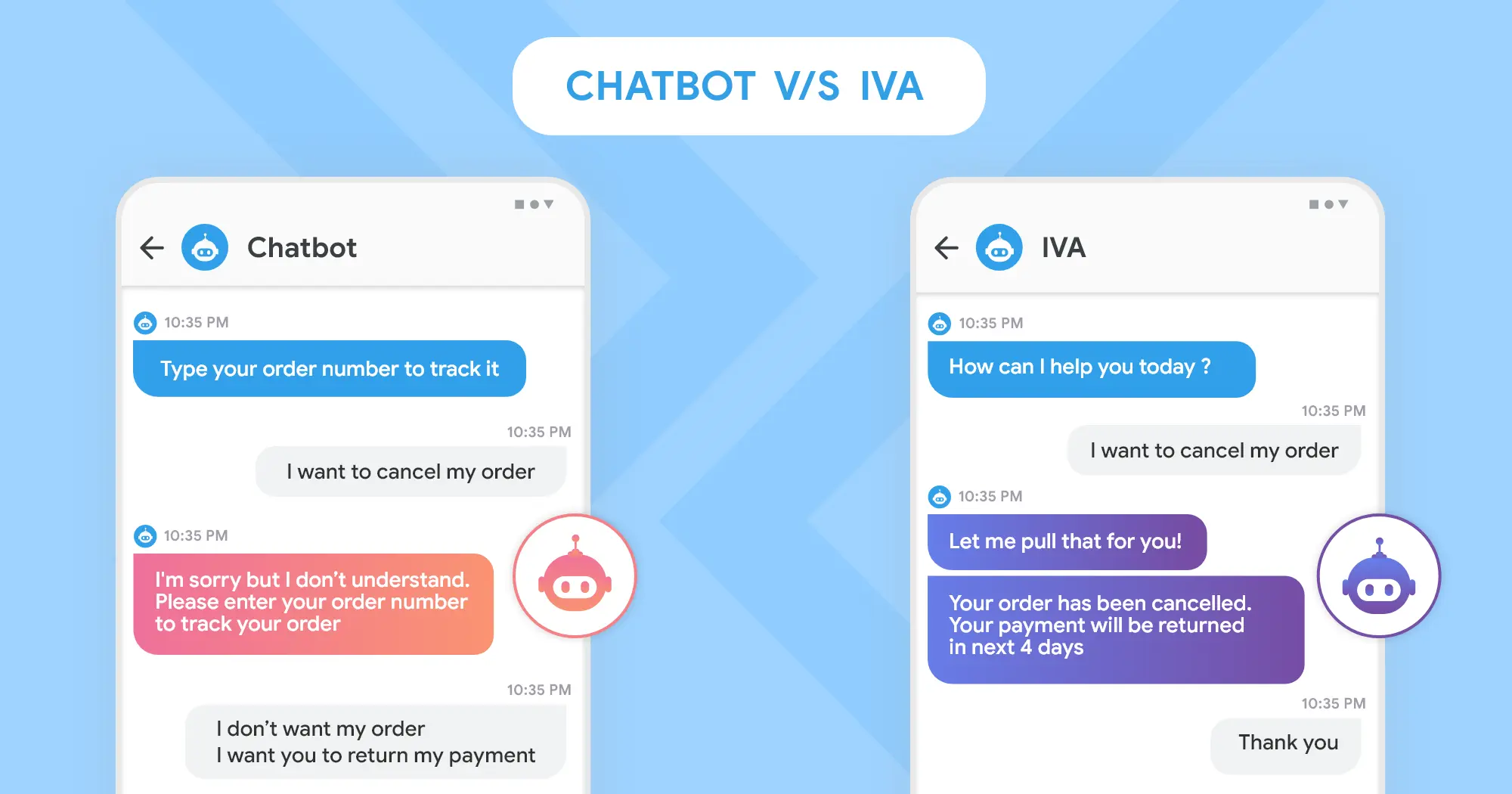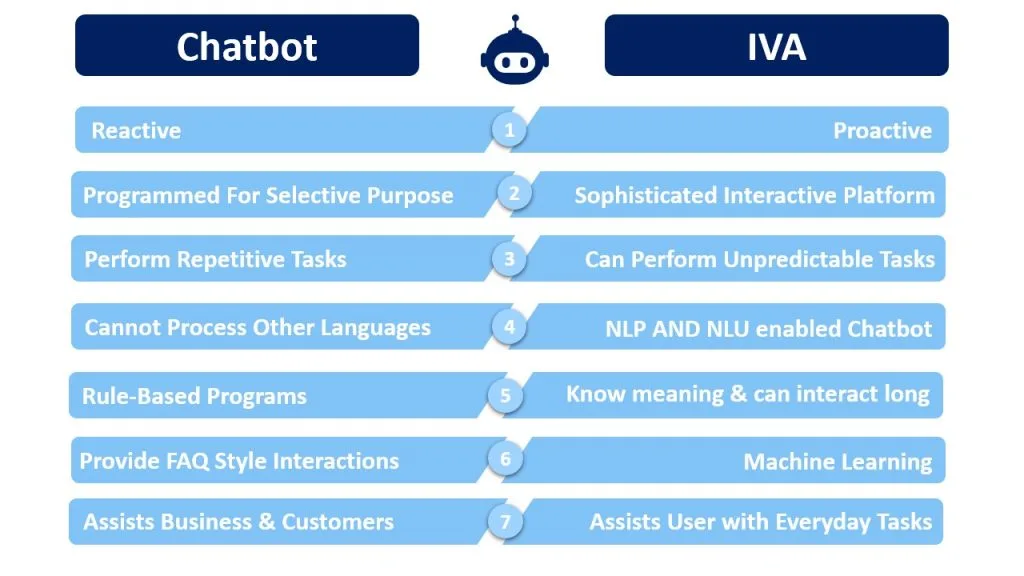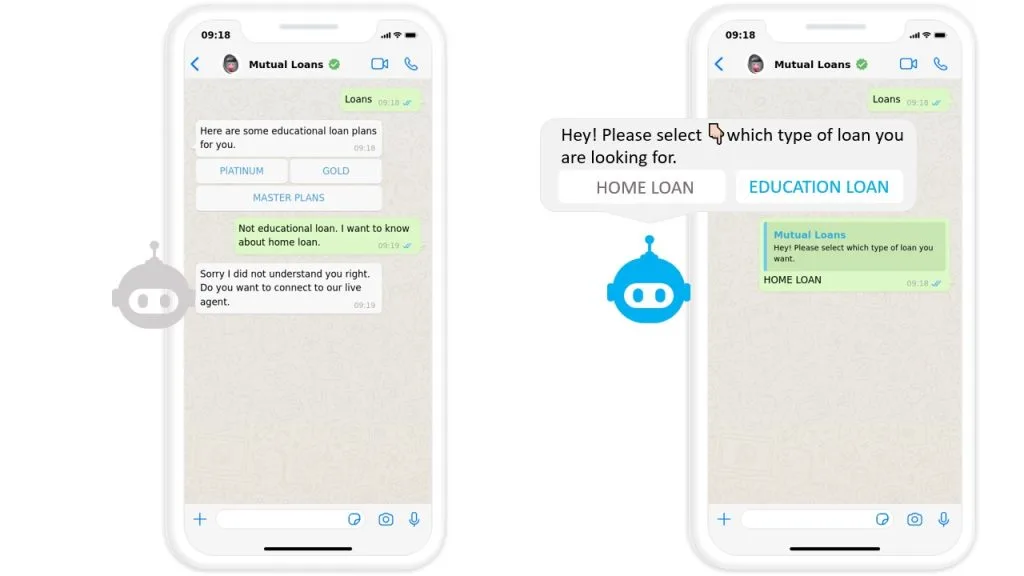Chatbot vs Intelligent Virtual Assistants: The Ultimate Showdown

- August 27, 2021
- Priyanka Shah
- Conversational AI, Engineering/ ML
The million-dollar question!!! Even though chatbots and intelligent virtual assistants are two ripened fruits of the same tree, it’s high time now that you join the wagon and know chatbot vs intelligent virtual assistants , because if Intelligent Virtual Assistants and chatbots appear identical to you then your understanding of these AI friends requires an upgrade. There is a serious difference among them that businesses need to know well before introducing chatbots or virtual assistants to their employees.
Still, CX and Digital Transformation professionals get confused and hence the question that always tags along is – can ‘chatbot’ and ‘Intelligent Virtual Assistant’ be used interchangeably? Or does their scope, capabilities, and complexity vary?
In layman language, IVAs are evolved chatbots to serve the requirements of a modern-day enterprise customer. Chatbots can be simply defined as rule-based systems which can perform routine tasks with general FAQs. While on the flipper side of the coin, advanced AI techniques aka IVAs, are fully equipped with Natural Language Understanding. It just gets better!! Advanced Natural Language Understanding aids in understanding and retaining context for polished conversations while carrying out a variety of tasks to fulfil a user’s requirements.
Drilling deeper down to understand how IVAs bypass its own ancestors, the chatbots.
Better understanding of user queries by IVAs
When user queries are at stake, chatbots have limited scope because they have been responding from pre-defined scripts. Whereas IVAs got the ability to find out over time and adapt to context for free-flowing chats. The focus of the whole market has transferred from process-centric conversational AI to customer-centric experience. Chatbots cannot adapt to complex situations and sentences with any business or brand-specific queries. This leads the way to bot breakage and heavier load on live agents, ending in a loop of poor Customer Experience.
Chatbots VS Intelligent Virtual Assistants
Let’s look after chatbot vs Intelligent virtual assistants key difference points which can help you to clear your doubts:
Chatbots and virtual assistants are both forms of artificial intelligence that can help automate tasks. Virtual assistants and chatbots differ primarily in their level of complexity when conversing with users or responding to their inquiries. Chatbots can respond to basic queries using natural language processing. On contrary, virtual assistants are more advanced and able to interact with users in a more conversational manner.
Chatbots are deployed with a set of predetermined responses that can be used in various scenarios. While virtual assistants are able to understand free-form human language better than chatbot systems. For example, a chatbot might respond to “What’s the weather like today?” with the current temperature, while a virtual assistant could provide more detailed information such as precipitation levels, wind speeds, etc. Virtual assistants also have access to more data sources than chatbots do, allowing them to offer more accurate results.

Use Cases of IVAs:
Here are some proven use-cases of IVAs having sure shot outperformed any regular chatbot:
1) To Maintain conversation context:
While chatbots are busy identifying only return users, IVAs are two steps ahead by keeping account of information derived from past user behavior and actions. This data can be used for more context in the upcoming conversations.
2) To Gauge Sentiments:
When IVAs are equipped with simulated ‘emotional intelligence’ which helps them analyze user emotions by perceiving customer mood based on sentence structures and speech patterns, there’s no chance that they are going to be bypassed by chatbots in this category. It’s all about adding to that human touch.
3) To Understand complex sentence structures:
Common human mistakes like the use of slangs, non-affirmative sentences, spelling blunders or in general any “negations” cannot be handled wisely by chatbots as they do not consist of any advanced techniques as in IVAs.
4) A Pro in handling user intents:
Factors like poor or vague intents and queries in natural human conversing language don’t stop IVAs from handling users with ease and prodding (not literally) users till it receives proper clarification.
Technical advancement of IVAs:
Don’t stop your praises for IVAs at their core capability of powering conversations because it also has a huge list of features to meet high demanding requirements of any brand. This can guarantee any brand or business with increase in ROI over time and justify the obvious: CX’s future is in the hands of IVAs.
1) Contextual AI to Agent handoffs:
There are situations when bot queries are passed to agents or customers demand talking with an agent. Now, normal chatbots would directly assign queries on predefined logic routes. However, IVAs check not only the agent’s availability but their capabilities before handling a query. Further, IVAs studded with NPL suggest answers to help agents and ease their work.
2) Leveraging Voice for Enhanced CX:
Voice bots are so much in trend. Isn’t it bizarre to think that there are now bots that listen to you and then respond with text or speech? NPU enriched IVAs understand what the customer wants to say and their underlying message and then responds back accordingly. To be honest, chatbots are not yet prepared for this, making them unreliable to provide customer assistance through speech.
3) Chat interface & user experience:
Customers already enjoy this automated chat thing that chatbots do and they literally don’t have to do anything except for adjuring the chatbot. But what if customers now get suggested replies in addition to the automated replies that the chatbot gives. Enters IVA!!! IVAs uses interactive reminders to get user’s attention based on predefined triggers. When the customers chat with the virtual assistance, there are auto suggestions from the IVAs side and the chat interface is dynamically configured to meet all the needs that the brands make for their design.
Examples showing Intelligent Virtual Assistant is better than Chatbot:
With all the hype and catchphrases out of the way, here are a few concrete examples to illustrate the differences between a chatbot and an intelligent virtual assistant:
1) Disambiguation:
Sometimes the user’s query content is simply insufficient for the chatbot to comprehend their intent. What would a real person do in this circumstance? They would clarify by asking a question. However, any effective AI virtual assistants must act in this manner. It ought to eliminate any confusion the user may have had regarding the query. Disambiguation has been shown to significantly increase IVAs’ overall automation levels, from about 70% to as high as 96%.

2) Retaining Context:
A chatbot is not developed enough to keep up with the information the user provided in earlier messages, whereas an IVA is able to retain context after a few messages are exchanged.

3) Spelling Errors & Slang:
Spelling errors can have many causes, and those causes can give rise to many different message intents or interpretations. In this situation, a chatbot would respond generically based on the best match. In contrary, an IVA would be outfitted with a powerful spell-checking model that would catch such errors. A well-designed IVA uses multiple spell-checking models to identify various spelling errors and variations and deal with them appropriately.

4) Paraphrases for Intents:
In our everyday language, we frequently combine several words to convey the same ideas. A good IVA should be able to identify the same intent using all conceivable word combinations.

To Sum Up:
With the rapid pace at which conversational AI technology is advancing, brands must maintain the evolving demands of their customers. Customers today expect a customer experience that’s engaging, easy, and online. With customer convenience in the middle of development, it’s time to maneuver to the following generation of text and voice-powered virtual assistants to escalate for your customer service.
Explore the next generation of customer support with Intelligent Virtual Assistants (IVAs), taking chatbots to the next level. Learn more in our article on Intelligent Virtual Assistants: The Next Gen of Chatbots.
One more thing of utmost importance is that both chatbots and virtual assistants have extensive potential to revolutionize business. The critical focus is to identify the right areas of application to strengthen your business by leveraging this AI duo. Are you thinking of creating an intelligent virtual assistant for your company? Reach out to Kevit.io or mail us at coffee@kevit.io to know about these automated applications and more.
See Kevit.io In Action
Automating business processes with Kevit.io is now just a click away!